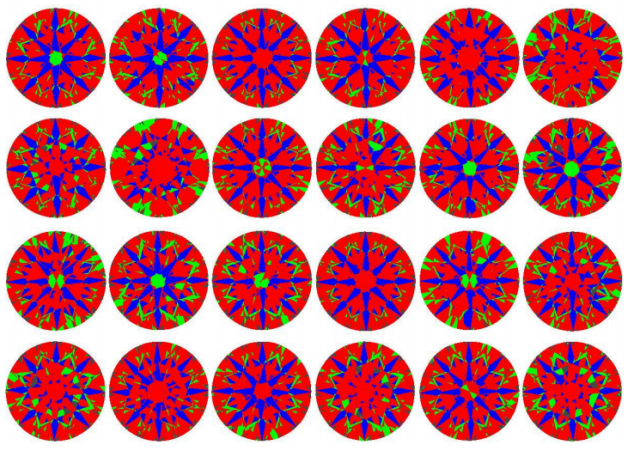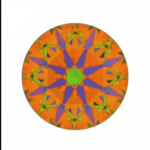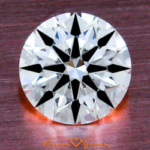Understanding The ASET (Angular Spectrum Evaluation Tool)
The more symmetrically perfect a diamond is cut, the more brilliance and fire is displayed to create scintillition, aka sparkle. Diamonds act as a compound mirror, with light reflecting off of facets creating mirror reflections throughout the crystal. These virtual facets are what gives a diamond life or the ‘sparkle factor’ something that makes diamond’s uniquely valuable over any other gem material.
But how does one evaluate the amount of light that is reflected from a diamond? Afterall, since a diamond is considered beautiful as a result of it’s brilliance, fire and resulting sparkle, how can we assess these seemingly subjective characteristics? This is the exact question posed by the American Gem Society and they have turned to simple science to help diamond professionals and the layman understand the intricate world of diamond light performance. The ASET or Angular Spectrum Evaluation Tool was developed to work alongside the AGS’s performance based Diamond Cut Grading System. This technology provides a quick and easy way to evaluate how a diamond interacts with light. ASET is available in both handheld or desktop models (for consumers or retailers) and is very simple to use and understand. When a diamond is viewed through an ASET, a color coded image can be seen. The different colors correspond to angles from which the diamond reflects light.
Red = 45º to 75º: Most Intense Light. Corresponds to a direct bright light source. Diamonds with high cut quality tend to show predominant red light reflection.
Green = 0º (horizon) to 45º : Less Intense Light. Corresponds to low-angle light; reflected from walls or other objects. Diamonds with high cut quality tend to show less green light reflection with the exception of some color surrounding around the outer rim of a round brilliant (bezel edge).
Blue = 75º to 90º: No Intensity. Corresponds to light that is blocked by a viewer’s head/body aka contrast. Diamonds with high cut quality tend to have moderate contrast in a symmetrical pattern helping to boost overall white light reflection.
Black/White: corresponds to areas that do not return light and is therefore considered ‘leaking light’ (depending on whether the background is white or black). Diamonds with very high cut quality will show very small areas of white or back sometimes around the bezel edge or none at all.
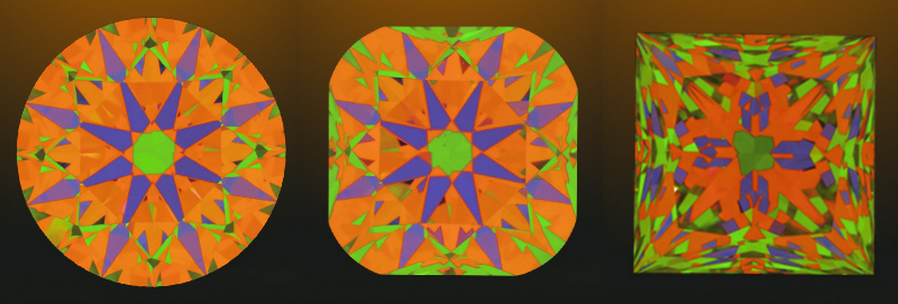
Examples of High Performance Diamonds in various shapes: H&A Round, H&A Cushion, and Princess. Predominant color in ASET image is RED. All diamonds from Brian Gavin Diamond’s ‘Signature’ collection of super-ideal diamonds.
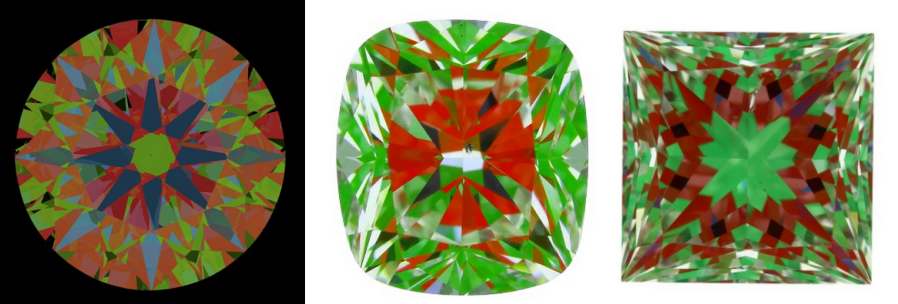
Examples of Medium Performance Diamonds in various shapes: Round, Cushion, and Princess. These diamonds show less overall RED with more less intense GREEN, assymetrical contrast pattern, and additional light leakage.
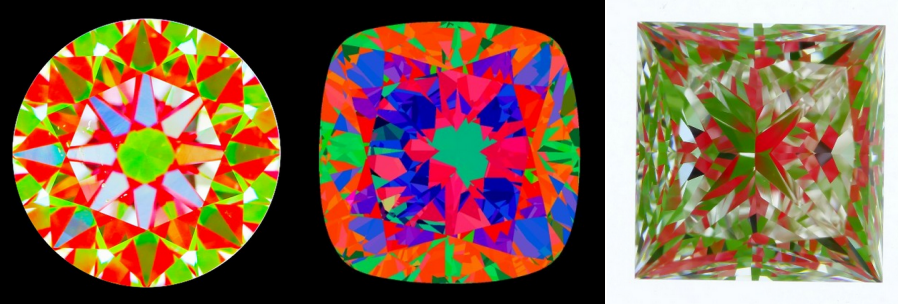
Examples of Low Performance Diamonds in various shapes: Round, Cushion, and Princess. These diamonds show little to no intense RED with chaotic light return, assymetrical contrast pattern, and significant light leakage.
An ASET image provides information on:
1. Light Performance
2. Optical Symmetry
3. Physical Symmetry
4. The Cutter’s Expertise (each image serves as a unique ‘thumbprint’)
It’s easy to see how much information is available in a simple ASET image of a diamond. This tool can be used to evaluate all diamond shapes, with different standards and expectations of light performance for each separate shape. As seen above, fancy shaped diamonds tend to show more green in their ASET image with assymetrical contrast patterning; this due to less cutting expertise for these less popular shapes.
AGS Allows For Personal Taste
Did you know that there are cultural and geographical preferences for diamonds? Everyone wants a bright diamond that reflects a lot of light. However, the balance between brightness, dispersion, and contrast can vary widely. Just take a look again at what AGS considers to be High Performance/Ideal cut diamonds:
As you can clearly see, all the above diamonds show large amounts of intense RED light reflection which means that they reflect a great amount of light. They are all bright with little to no light leakage. However, we can easily see that the contrast patterning isn’t symmetrical in all cases and some diamonds elicit more fire (rainbow of colors) while others elicit more brilliance (white light reflection). This means that when you move the diamond, the sparkles that you will see will either be more bright white flashes or rainbow color flashes. Cut as you have already guessed, is a very complicated subject with regard to diamond light performance.
You may wonder why such a large variance exists. Afterall, if you are taking the time to invest in your diamond education, you’ll wonder why anyone would want a less than perfect ideal cut diamond? The reason why AGS still allows for a wide range of ‘tastes and personal preferences’ is largely due to ignorance and how that affects the industry as a whole. As most people (retailers/diamond dealers/consumers) are not educated on light performance technology, the world still has some catching up to do. Thus, as a business, AGS must still maintain a wide range to accommodate different markets that are still operating under less educated means for buying and selling diamonds. AGS is still the leader in cut evaluation, but it is important to realize that you will encounter different varieties of High Performance diamonds on the market (as seen above).
Things To Remember:
- Out of the 4 C’s, cut has the greatest effect on a diamond’s beauty
- Cut quality is the biggest contributor to light performance
- Cut proportions are important, but no there is no set of proportions (table %, depth %, crown and pavilion angles) that will guarantee a High Performance/Ideal cut diamond
- A lab report cannot be used to determine the beauty, value, or quality of diamond. You must see the diamond via images/videos/in person for this.
What Are YOU Looking For?
If you are overwhelmed, don’t be. Just when you thought that this diamond buying business has gotten far too complicated for you, there is a very easy way to purchase without getting a huge headache. There are diamond vendors out there that have done all the screening work for you and sell only the very best light performance diamonds (perfect optical symmetry and equal balance of fire/brilliance). Brian Gavin owner of BGD meticulously screens each and every diamond that he sells, allowing for consistent and predictable quality and value.
The precision H&A contrast pattern coupled with a very narrow range of proportions within the AGS Ideal Cut grade system results in diamonds with a higher number of virtual facets that produce larger flashes of brilliance and dispersion along with superior scintillation/sparkle. They are the only super-ideal diamond retailer that has dependable, ethical, and consistent quality control in their hearts and arrows diamonds. Their diamonds are what every other vendor retailer strives to emulate.
If you have any questions evaluating an ASET image or would like diamond recommendations for your personal taste and budget, please don’t hesitate to contact me.
Happy Diamond Buying!
Hey.You Want Ideal Cut Diamonds?
You've got it.
Join ODBA's Diamond Deal Friday and get handpicked diamonds every week from me to you.
No consultation required. Subscribe now!
ODBA Recommends
You May Also Like

